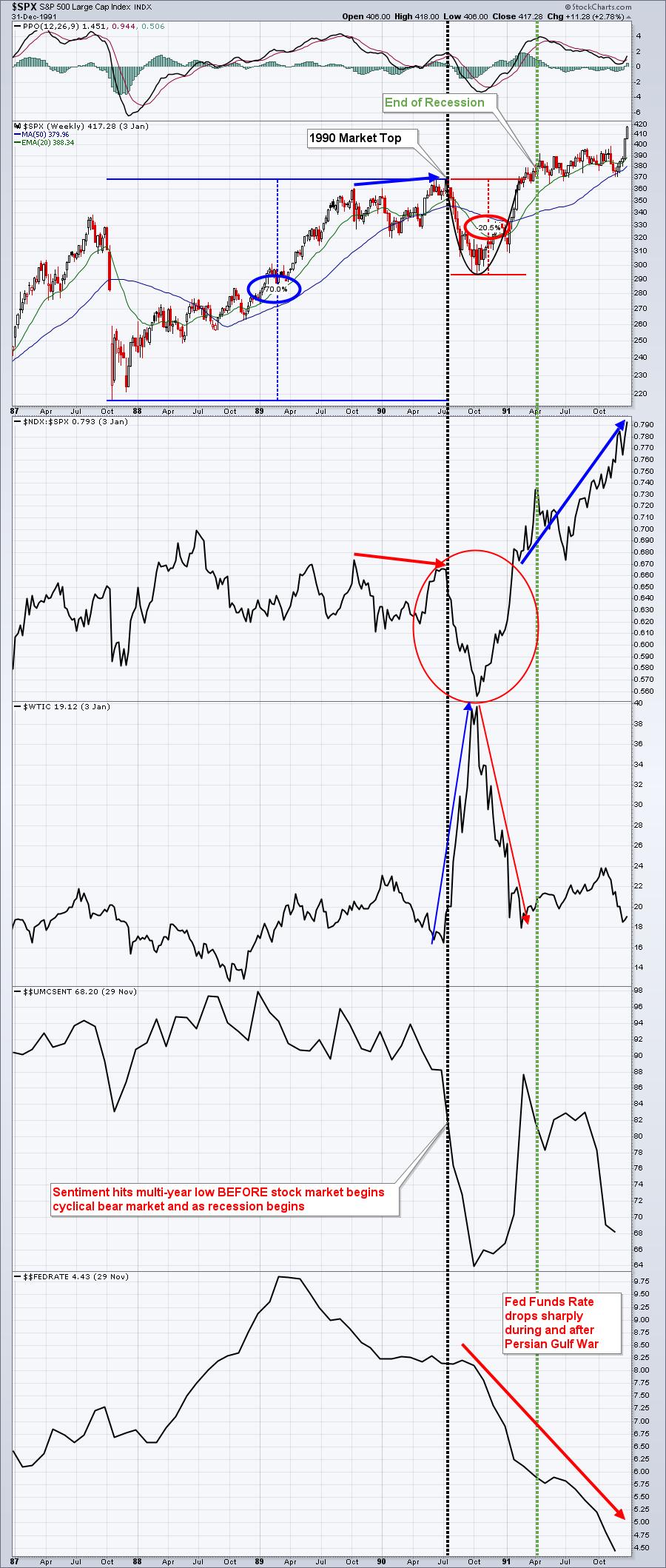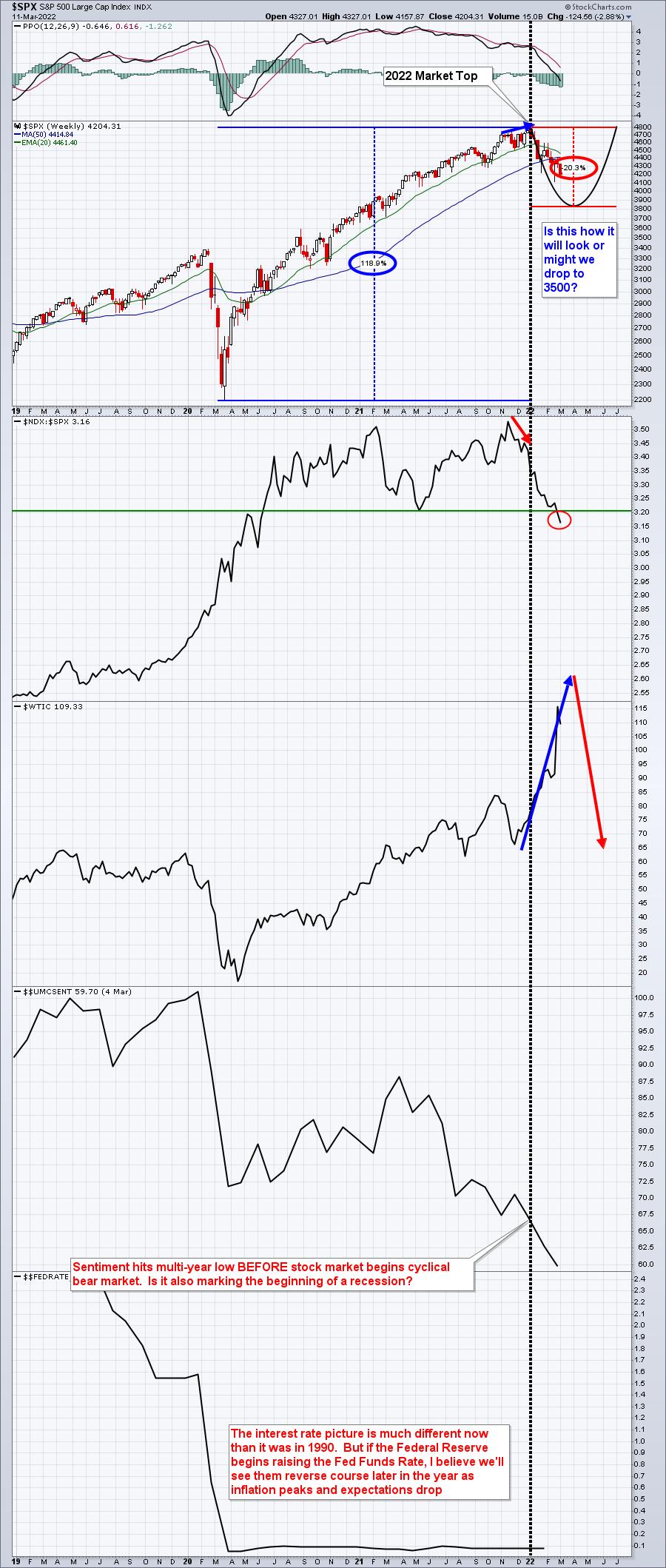We saw the latest CPI report (February) released on Thursday. It came in about as expected, with the February Core CPI rising 0.5%, matching consensus estimates. That sent the annual core inflation rate HIGHER (as I've previously suggested) to 6.4%, the highest rate we've seen in more than 4 decades. The media, once it grows tired of the Russian-Ukrainian war, now has new inflation material to work with.
The high volatility ($VIX) and the big swings back and forth characterize the late stages of a cyclical bear market. The characteristics of our current market environment and that of the 1990-1991 cyclical bear market are remarkably similar -- almost eerily similar. I believe studying this period would do all of us a lot of good right now. Let's talk about 1990.
1990
During the 1990 cyclical bear market, we had (1) a prior run up in the S&P 500 of 70% in 2 1/2 years, (2) the Persian Gulf War, (3) surging oil prices (rose 147% in just a few months), (4) falling consumer sentiment, (5) failed NASDAQ leadership at the final 1990 high and (6) much of this leading us into a fairly mild recession. It all started about 9 years into a secular bull market that began in the early 1980s. Does any of this sound somewhat familiar? Here's the chart summarizing all of this from 1987 through 1991:

2022
In the famous words of baseball legend Yogi Berra, it's "deja vu all over again!" I'm going to show you the current S&P 500 chart with exactly the same panels beneath it, so you can study the similarities between now and 1990:

A move down to roughly 3800 on the S&P 500 would approximate the cyclical bear market decline of 1990. A few points that I believe are very important as we study these two charts:
- The similarity in consumer sentiment is astounding -- the March consumer sentiment number was released Friday morning, showing another large decline.
- The soaring crude oil prices are resulting in inflation spiraling higher and will increase recession probabilities.
- Our 2+ year rally in 2020-2021 was approximately 119% off the March 2020 low, a much larger advance than we saw prior to the 1990 cyclical bear market. Will this mean a bit larger decline for this cyclical bear market? Could we see 3500-3600? I think it's very possible.
- The final move lower in cyclical bear markets tends to be the worst with the highest volatility ($VIX). Predicting where the VIX might top is nothing more than a guess. History tells us that ANY VIX readings in the upper-30s and throughout the 40s have been GREAT BUYING OPPORTUNITIES historically, even if you don't catch the exact bottom. Sometimes you fall another 5-10% very quickly, but the recoveries are usually insanely quick. Emotionally, it's very difficult to pull the trigger and buy AFTER a bottom has formed and a rally is underway. So "holding your nose" and buying into extreme weakness is typically the best strategy to ensure low entry prices.
- I could be completely wrong. Maybe we never get to 3800 or 3500. Or maybe we don't stop there. But my indicators, along with history, suggest that it's prudent to consider much of the above as the "most likely" path of the stock market, NOT the guaranteed path.
- There's also the possibility that it takes longer to recover back to prior all-time highs. I could most definitely see a scenario where we don't see another all-time high on the S&P 500 until late in 2022 or in 2023.
The biggest difference from 1990 is that the fed funds rate is obviously much, much lower now and near zero. There's no room to lower rates right now. In 1990, the fed funds rate was lowered in December by 50 basis points as a result of the recession.
The Federal Reserve meets on Tuesday and Wednesday of next week. Fed Chair Jay Powell is set to embark on the wrong policy, in my opinion, of raising rates, which will be the final nail in our economic coffin. That, combined with soaring crude oil prices and declining consumer sentiment, will throw us into a mild recession -- similar to 1990. But I wouldn't expect the stock market selling to be mild. In fact, I'm looking for the decline to accelerate in the second half of March. If I'm correct, it'll represent a great opportunity to reverse course and switch from short selling back to the long side as the reward-to-risk will turn decidedly in favor of the bulls. I fully expect that later this year, after our economy has weakened, the Fed will reverse whatever rate hikes they chose to fight inflation.
When and whether to buy during a cyclical bear market is, quite honestly, up to each individual based upon your own unique financial situation and objectives. I believe the current stock market volatility and worries will resolve similarly to 1990, including the subsequent significant outperformance of the NASDAQ 100 vs. the S&P 500.
Time will tell.
I write a FREE EB Digest newsletter 3x per week. You can subscribe by CLICKING HERE to provide your name and email address. There's no credit card required and you may unsubscribe at any time. In Monday's EB Digest, I'll discuss a company that I believe will be crushed by the Fed's rate hike on Wednesday. Don't miss it!
Happy trading!
Tom
